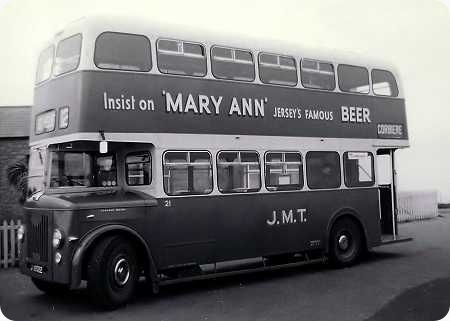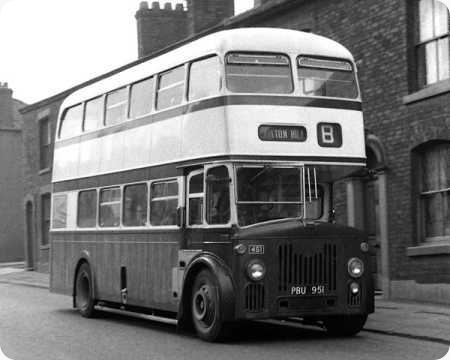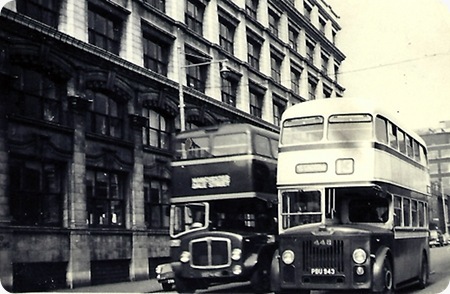Jersey Motor Transport – Leyland Titan – J 16522 – 21
Jersey Motor Transport
1955
Leyland Titan PD2/22
Metro Cammell H31/26R
When Leyland Motors finished building bus bodies, the Jersey Motor Transport Company went to M.C.W. for their next double deck bodies. Two were bought in 1955, the other being J 16521, fleet number 20. They were the first Double Decker’s in the fleet with ‘Tin Fronts’ and Lightweight bodies. It was reported that the seats were hard, and the bodywork rattled. But the Drivers liked them because they were nippy vehicles.
They served in the fleet for 16 years, being withdrawn in 1971, when Bob Lewis, from Trimdon Motor Services bought the J.M.T., and brought in more saloons, and gradually replaced Double Decker’s and Conductors. He also repainted the fleet in to a Blue livery getting rid of the Green/Cream used for many years. This was so vehicles could be moved between Trimdon and St Helier without repaint. J 16522 No 21 is seen here at the Corbiere Terminus of Route 12. Incidentally both vehicles 20 and 21 were actually scrapped on the island of Jersey.
In this photograph the Driver has changed the blind to St Helier, but the Conductor has yet to change the platform blind from Corbiere.
The advert is for Jersey’s Famous Beer ‘MARY ANN’ which has been Jersey’s local brew for over the last 100 years. Most of JMT buses through out the years carried an advert for ‘MARY ANN’ in one form or another. The building in the back ground is the old Corbiere Terminus Station (it is now a private residence) of the Jersey Railways & Tramways Limited, this company taking over the assets of the Jersey Railway Company Limited on 1st February 1896. The extension from St Aubin’s (the original terminus) to Corbiere being opened in 1899. The whole railway shut, after a fire broke out in St Aubin’s Station in the early hours of 18th October 1936, when the station buildings were badly damaged and 16 of the best carriages were destroyed.
Photograph and Copy contributed by Stephen Howarth
A full list of Titan codes can be seen here.
———
14/02/12 – 07:51
This is another example of the much maligned Orion design looking quite attractive. This is helped by the layout of the livery, a style which suited the Orion very well. The ones at Brighton which had the same livery layout but red instead of green always looked attractive to me.
I always thought JMT was owned by the Jersey Government and had no idea it was bought by Trimdon Motor Services. That seems a strange commitment for a relatively small North East based independent. My former employers did some construction work in Jersey (nothing to do with transport) and found it a difficult place to operate. Shall we just say there were a lot of ‘vested interests’!
Philip Halstead
———
14/02/12 – 07:53
The Orion body was not the most attractive of designs and adding it to the tin front ‘Midland Red’ Leyland chassis did it no favours. Mix that with a 7’6" wide chassis as in the case of JMT 21 and the result is positively undesirable, in my opinion. It looks narrow and top heavy, and that is from a side view!
Having said that the Orion body could be made to look quite reasonable if painted in a smart livery with lining out, for example, Halifax, Bradford or West Bromwich.
Equally, the BMMO style tin front Titan could be made to look quite attractive if it was fitted with a good looking body and smart livery, such as the Roe bodied Sheffield PD3’s shown in the previous posting. Perhaps a smart livery and body style draws the eye away from the plain BMMO style Leyland front. Who knows, beauty is in the eye of the beholder!
Eric
———
14/02/12 – 08:50
Know what you mean, Eric. I generally prefer exposed radiator PD3s – especially the Stockport’s. Sheffield’s tin fronts, however, do work.
As Charles Roe’s biggest fan, how is this for a variation on a theme (of livery improving an Orion)? Of all the many variations on offer, I found the worst looking one to be the front entrance PD3 – with several Doncaster operators, including the Corporation. Over the Pennines in Oldham (HQ of the Roe appreciation society?) their last traditional buses were front engined Roe/PD3s – which looked superb in their smart livery. So it can work both ways!
David Oldfield
———
14/02/12 – 11:27
Newcastle Transport had some very similar ‘tin front’ Orion PD2’s but Tyneside’s were the exposed radiator type, whilst the rest of the Northern groups Orions were Guy Arab’s They were all what could be best described as ‘cheap and chatty’ on the upper deck, with single skins and exposed frame’s, hence all the knocks bangs rattles and squeaks, but to be fair to the later PD3’s, although apart from being longer they looked very much the same from the outside, they were an entirely different beast inside, with double skins and sound proofing.
Ronnie Hoye
———
14/02/12 – 16:29
I should have mentioned in my original description that there is a Society devoted to the Channel Islands Bus scene.
This is the Channel Islands Bus Society.
Details can be obtained (please enclose a SAE), from
Dr Jim Young, 67 Boston Avenue, Southend on Sea, Essex, SS2 6JH.
Newsletters are published in Spring, Summer, Autumn, and Winter. Subscriptions are £14 per year for UK and CI residents or £17 for other EU countries.
Stephen Howarth
———
14/02/12 – 16:31
The demise of the Leyland bus-body building activities 1954 was a great loss to the bus industry. The alternatives such as the MCW Orion body must have been a great disappointment yet this style of body started a trend by other body builders such as Park Royal and Roe who attempted to copy and go lightweight.
However a good livery such as on the JMT Leyland does improve matters a little but inside comforts and appearances such as front dome of rough fibre-glass make me wonder how Weymann and MCCW could change from their previous classical and quality bodywork finishes.
My first view of a MCW Orion body was Yorkshire Woollen Leyland PD1 in overall red livery in Leeds in 1955, which was a shock to my senses.
Fortunately some operators such as Liverpool CT demanded a better specification and MCW gradually changed and improved their designs in the sixties.
Richard Fieldhouse
———
10/04/12 – 06:24
I wasn’t keen on the Leyland tin front either and another Orion/Tin front combination which looked awful was a batch of PD2s delivered to Bolton which had the full front design, also used by Blackpool.
David Pomfret
———
11/04/12 – 06:05
Regarding the comment by Mr Fieldhouse regarding the Yorkshire Woollen bus he saw just to set the record straight this was not a PD1 these buses were rebodied Leyland PS1s. Their Orion bodies were actually lighter than their original Brush single deck bodies. They were always called Cans or Salmon Cans by us enthusiasts. My wife used to conduct on them and she always said they were very cold in winter possibly because they had no internal lining panels to keep the weight down.
Philip Carlton
———
11/04/12 – 15:35
Edinburgh bought many MCW bodied PD2s with tin fronts for tram replacement. This lead a councillor to comment on them by calling them Monstrous masses of shivering tin the only modern thing about them is their approximation of rock and roll when moving! Edinburgh liked the Leyland tin front so much they retro fitted it to some exposed radiator PD2s and also some rebuilt Guys. They also continued to fit it to new deliveries until 1966 long after the St Helens version superceded the original. In the end they built their own fibre glass version in house.
Chris Hough
———
22/04/12 – 16:13
Nice to see a picture of JMT 21 taken when new at the Corbiere terminus Route 12. I have seen a pre-delivery shot of the sister J16521 but not 21 new.
Does the copyright owner have any other pictures of any other vehicle in Jersey at this time? I have a good collection of Jersey photos both pre and post war, but I am always looking to add to my collection.
John Luce
Quick links to the - Comments Page - Contact Page - Home Page



